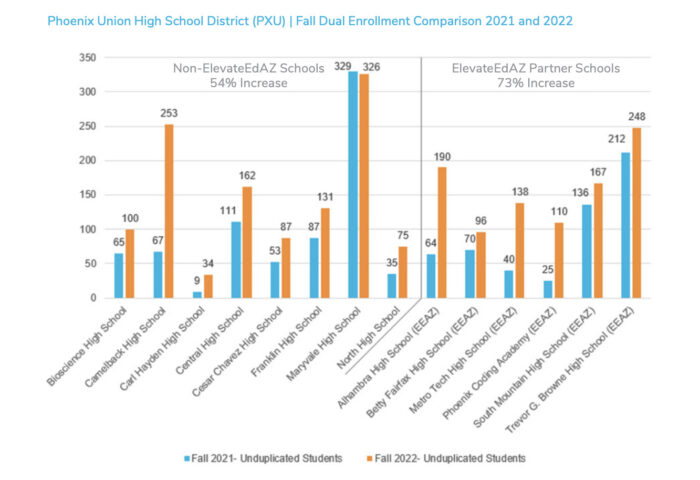Cultivating Pathways to Postsecondary Success
Colleagues,
Earlier this month I had the opportunity to join several of our Accelerate ED grantees and other leaders in the education pathways space in Washington D.C. to discuss lessons we’re learning from efforts to scale high-quality, accelerated postsecondary pathways in states across the country. Learn more about the lessons learned from the Accelerate ED teams in The 74.
As we discussed common themes, opportunities, and challenges, and how communities are responding to this work, I was struck by how important it is to be clear about what we mean by “high-quality, accelerated postsecondary pathways.” As we seek to build awareness and support for pathways approaches in communities across the U.S., it is critical that we help key stakeholders understand that
“pathways” isn’t a single thing, but rather an approach to fitting critical elements together in a coherent and structured way.
In our work at the foundation, we think of pathways in terms of specific “ingredients” that together create clear education pathways, such as intentionally sequenced coursework, work-based learning opportunities, targeted advising and support for students, stackable credits, as well as a commitment to equitable outcomes and building social capital that connects students to clear career paths.
In this week’s newsletter, we’re highlighting dual enrollment – which we think of as a key mechanism, or “ingredient,” for building and delivering these types of coherent pathways. To stretch this analogy a bit, think of high-quality accelerated postsecondary pathways as cake. A number of ingredients go into making that cake and the same is true for building high-quality accelerated postsecondary pathways. Dual enrollment is like eggs. Eggs can be great by themselves, but they are even better when mixed with other ingredients to make something special. Just like mixing the ingredients together and then baking the cake, there is a need for cohesion and integration when building these pathways in order to truly serve students and move students forward. The power is in bringing the ingredients together to serve students, especially students who would not otherwise go to college and have these opportunities.
In future editions of this newsletter, we look forward to highlighting other ingredients and work happening in the field. This month we are serving up some pretty terrific “eggs,” including some great work being done by ElevateEdAZ and the Aspen Institute.
Sara Allan

Director, Early Learning and Pathways
Gates Foundation
In this issue of Wayfinders: learn about how ElevateEdAZ’s Dual Enrollment Project impacted two school districts. We also highlight the Aspen Institute’s dual enrollment curriculum resource.
ElevateEdAZ: Fall 2022 Dual Enrollment Project Summary

How can schools and districts increase dual enrollment participation? Arizona’s Accelerate ED team, ElevateEdAZ, which includes Maricopa Community Colleges District funded a project to understand the barriers to dual enrollment and develop short-term and long-term goals to increase dual enrollment attainment.
A growing body of research suggests that students who complete college courses through dual enrollment are significantly more likely to attend, persist in, and complete postsecondary education.
In fact, the 2022 project summary report highlights how two Arizona school districts saw success from an action plan to increase dual enrollment opportunities.
This report indicated four key focus areas for increasing opportunity for all learners:
- Students and Families: students have the opportunity to take 12 college credits (or 30 college credits if on an accelerated year 13 associate degree pathway) and understand the value of dual enrollment.
- Teachers and Faculty: teachers are motivated to teach dual enrollment courses and can become qualified.
- Intentional Alignment: dual enrollment courses are a valuable use of time and resources for students.
- Administration and Planning: project partners sustain a strong, seamless partnership resulting in student success.
As a result of this project, there was a 40% increase in students registered for dual enrollment with Maricopa Community Colleges as compared with the prior year. This is further evidence that access to dual enrollment is a key ingredient to high-quality accelerated postsecondary pathways and essential to closing equity gaps in education.
For more on how Arizona is cultivating pathways to postsecondary success, read Billions to Gain: The Economic Benefits of Investing in a More Educated Arizona, a new report from the Helios Education Foundation & Education Forward Arizona. Among the recommendations included are “bolstering college readiness efforts and strengthening the linkages between the K-12 and postsecondary education systems, such as through expanded access to dual enrollment and promotion of student-centered pathways.”
Aspen Institute’s Dual Enrollment Curriculum
Dual enrollment students are the only growing student population at community colleges. In response, the Aspen Institute has created materials that can help community college leaders expand and improve dual enrollment, such as learning how to explain:
- The importance of excellence and equity in dual enrollment to the broader student success mission
- The roles of senior leaders in achieving strategic and equitable impact through dual enrollment
- The current state and context of dual enrollment at their colleges
- How to build effective external partnerships with K-12 and other key stakeholders
In addition, these materials explain how community college leaders can develop a compelling vision for dual enrollment that will advance excellent and equitable student outcomes. Check out the resources here.
What We Are Reading
- TODAY Show: PeerForward takes peer-to-peer approach to college applications
- It Should Be Easy for Black Teens to Take College Classes
- Recording – Introducing Launch: A Conversation on the Future of College and Career Pathway
- Adding a 13th Year to K-12 for College and Career Success
- Not Just Another College-to-Career Initiative: Advancing Equity and Economic Prosperity Through California Regional Collaboratives
- Is Jobs-Based Education Coming to a School Near You? NYC Hopes So



